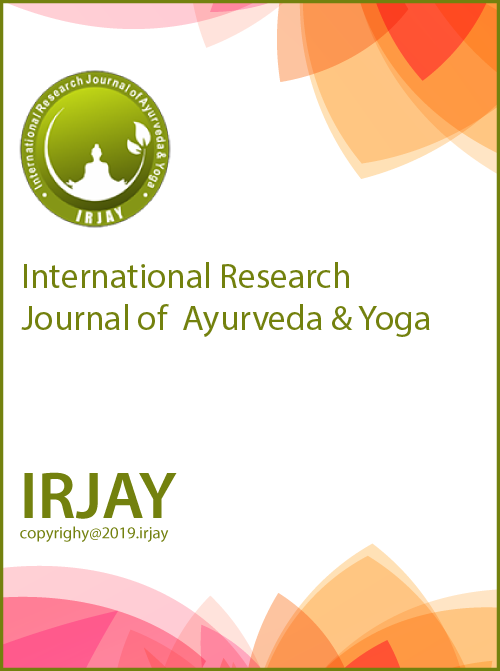A Review Article on Katishoola with Special Reference to Lumbar Spondylosis
DOI:
https://doi.org/10.48165/IRJAY.2025.80513Keywords:
Katishoola, Lumbar Spondylosis, Vataja Nanatmaja VyadhiAbstract
In the new millennium, the progressive and fast lifestyle, unhealthy eating habits, work which includes long sitting hours, improper sitting and sleeping postures, frequent traveling, jerks while traveling, sports activities, and lack of physical and mental exercises have been known to cause one of the most common complain to visit a doctor which is the low backache. Spondylosis refers to the degenerative changes in the spine, such as bone spurs and degenerative changes in the intervertebral disc. Lumbar spondylosis is a musculoskeletal disorder in which there is degeneration of the lumbar spine which causes low backache. The degenerative change is followed by the narrowing of the intervertebral disc space, which leads to compression of the spinal nerves that exit the spinal cord. This compression of the spinal nerves leads to pain, numbness, stiffness, and tingling sensation in the legs. In Ayurveda, low backache can be correlated with Katishoola, which is a “Vataja Nanatmaja Vyadhi” and produces symptoms such as pain and stiffness in the Katipradesha.
Lumbar Spondylosis is a degenerative condition of the lumbar spine that presents with narrowing of the disc space and compression of the spinal nerves, which further leads to pain in the lower back radiating to the legs and also cause numbness, stiffness, and tingling sensation in it. Unhealthy eating, a modern lifestyle, repetitive trauma to the spine, lifting heavy weights on the back, and long sitting hours with improper posture are known to act as the aggravating factors of low backache.
In Ayurveda, this condition can be correlated with Katishoola. According to Acharya Sharangdhara, Katishoola is a “Vataja Nanatmaja Vyadhi.” Among the Tridoshas mentioned in the classical texts, Vata dosha plays a major role in the occurrence of diseases as the other doshas, dhatus, and malas are said to be “Pangu” without Vata dosha as mentioned by Acharya Sharagdhara. Katishoola has not been described as a separate disease in the classical texts, but references of Katishoola as a symptom of various diseases, such as Asthimajjagata
Downloads
References
1. Monier Williams M. A sanskrit English dictionary. Delhi: Motilal Banarsidass Publishers Private Limited; 2002. p. 243.
2. Kasper DL, Fauci AS, Hauser S, Longo D, Larry Jameson J, editors. Harrison’s principles of internal medicine. 21st ed., Vol. 1, Ch. 17. New York: The McGraw-Hill Companies, Inc.; 2015. p. 117.
3. Kasper DL, Fauci AS, Hauser S, Longo D, Larry Jameson J, editors. Harrison’s principles of internal medicine. 21st ed., Vol. 1., Ch. 17. New York: The McGraw-Hill Companies, Inc.; 2015. p. 120-4.
4. Jhadvji T. Kashi sanskrit series 228. Ch. 28., Sloka 56. Varanasi: Chaukhambha Sanskrit Samthan; 1994. p. 615.
5. Trikamji Y. Sushrutha samhitha nidanasthana. Krishnadas ayurveda series 511. Sloka 21. Varanasi: Krishnadas Academy; 1980. p. 301. 6. Murthy KR. Ashtangahridaya suthrasthana. Krishnadas academic series 4. Ch. 12., Sloka 49. Varınasi: Krishnadas Academy; 1982. p. 200.
7. Upadhyaya Y, editor. Madava nidana. 3rd ed. Ch. 25., Part 1., Shloka 7-8. Varanasi: Puth Chaukhamba Sanskrit Bhavan; 2000. p. 575.
8. Tiwari PV. Kashyapa kashyapa. Siddhi sthana 5/9. Varanasi: Chaukhambha Surabharathi Prakashana; 2002.
9. Sharma PV, editor. In: Murthy KH, editor. Bhela bhela samhita. 1st ed. Sutrasthana 10/3. Varanasi: Chaukhambha Orientala; 2000.
10. Triphati B. Sharangdhara sharangdhara samhita with Deepika and gudartha Deepika tecka porva ghanda. 2nd ed., Ch. 7., Shloka no. 105. Varanasi: Krishnadasa Academy; 1986.
11. Mishra S. Bhava mishra bhava prakasha with vadyotini Hindi teeka uttarakhanda. Ch. 26., Shloka no. 53. Uttarakhands. Uttar Pradesh: Chaukhambha Sanskrita; 1990.
12. Shastri RD. Harit Samhita. 1st ed. Ch. 22/1. Varanasi: Krishnadas Academy; 1992.
13. Tripati I, Tripati DS, editor. Yoga ratnakara. 1st, 10th, ed., Part 2. Varanasi: Krishnadas Academy, Chaukhambha Sanskrit Sansthan; 2002, 1998. p. 231, 157.
14. Tripati I, Tripati DS, editor. Yoga ratnakara. 1st ed. Varanasi: Krishnadas Academy; 1998. p. 401.
15. Tripati I, Tripati DS, editor. Yoga ratnakara. 1st. Varanasi: Krishnadas Academy; 1998. p. 402.
16. Pandeya SG, editor. Gadanigraha. Ist ed., Ch. 19., Part 2., Shloka no. 160. Varanasi: Chaukhamba Samkrit Series Office; 1969. p. 508.
17. Mathur DS, editor. Brihat nighantu ratnakara. 1st ed. Delhi:
18. Kamat SD, editor. Dhanvantari nighantu. 1st ed. Delhi: Chaukhamba Sanskrit Pratistan; 2002. p. 57.
19. Pandey G. Vinodlalsen: Bhaishajya ratnavali, banarаs ayurved series no 8. 1st ed. Varanasi: Chowkhamba Sanskrit Series Office; 2007. p. 14-7, 624-6.

